Fresh Lemon-Blueberry Scones
This post may contain affiliate links. Please read my disclosure policy.
This lemon-blueberry scone recipe yields a flaky, buttery, sugar-crusted, and berry-loaded scone. Buttermilk makes the crumb especially tender, and a hint of fresh lemon zest so nicely complements the berries, adding a touch of brightness, too.
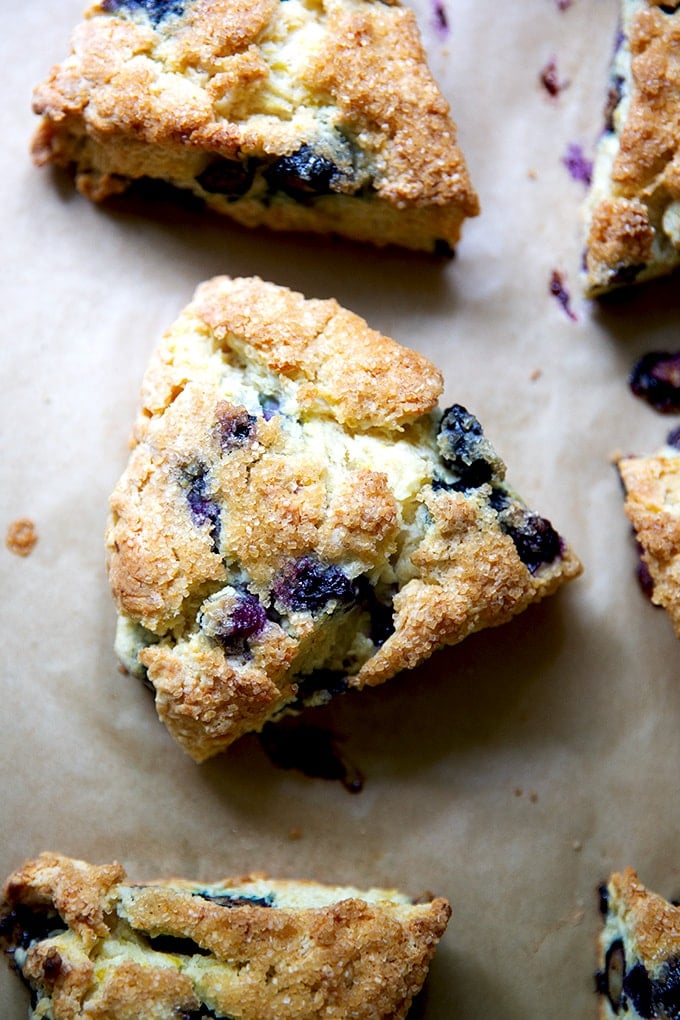
You might recall my obsession with Tartine? When you live hundreds of miles from this magical bakery, it’s good to have a few of their tricks up your sleeve. This lemon-blueberry scone recipe is a great place to start.
The key to making a good scone is similar to making a good pie crust or a good biscuit:
- Use cold butter.
- Handle the dough minimally.
Keeping the butter cold creates a flakiness in the finished pastry. Handling the dough with a light touch ensures the crumb will be tender.
There are a few ways to “cut” cold butter into dry ingredients:
- A pastry cutter: This hand-held, u-shaped tool works well if you have a sturdy one with solid (as opposed to wire) “blades”. I find pastry cutters to be a little tricky initially — they slip and slide — but once you make a few cuts, they beautifully “cut” the butter into the dry ingredients.
- The back of a fork: The back of a fork works similarly to a pastry cutter, but will require a little more elbow grease.
- Food processor: Ten 1-second pulses in the food processor will quickly cut butter into dry ingredients, as in this pie dough recipe. Finish the scone dough by hand, however: once the butter is cut into the dry ingredients, transfer it to a bowl and add the buttermilk and blueberries; combine using a wooden spoon or spatula.
- Box grater: If you freeze the butter before using it, you can run it down a box grater to create fine shreds, which will incorporate easily into your dry ingredients.

Three More Tips for Excellent Scones
- Use buttermilk: Buttermilk tenderizes gluten, which promotes a tenderness in the final product. It also offers a nice tang.
- Add citrus zest: Fresh lemon or orange zest makes all the difference in a pastry, offering a touch of brightness as well as a nice complement to the sweet fruit.
- Use the tea towel trick to shape: To prevent overworking the dough, mix it with a spatula until you have a shaggy dough; then transfer to a large tea towel and twist it into a beggar’s purse to bring it together.
PS: I use this same base recipe to make Buttermilk Currant Scones and Cranberry-Orange “Snow” Scones.
More Lemon-Blueberry Recipes
- Lemon-Blueberry Dutch Baby
- Lemon-Blueberry Muffins
- Buttermilk Blueberry Breakfast Cake
- Lemon-Blueberry Quick Bread
How to Make Blueberry Scones
First, gather your ingredients: flour, salt, baking powder, baking soda, sugar, butter, berries, buttermilk, and a lemon.
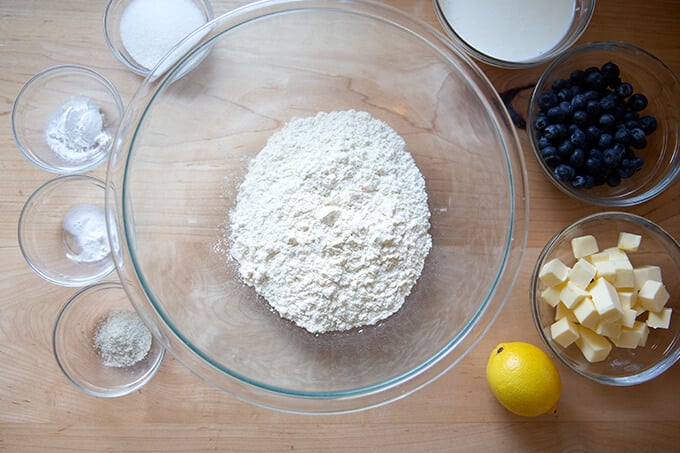
Next, mix the dough just until it comes together (video guidance above and in recipe card):
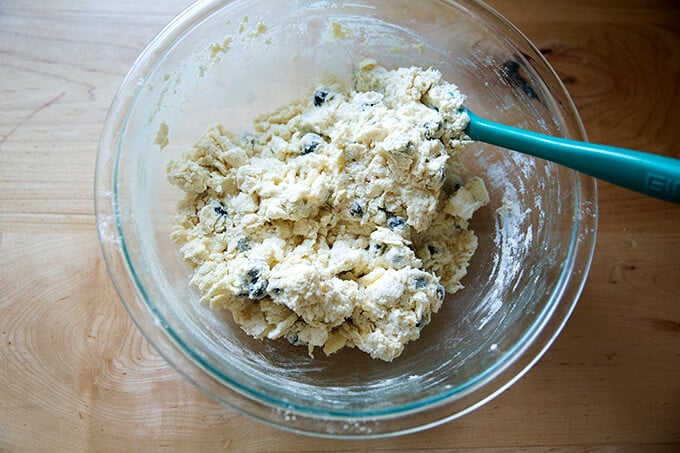
Turn it out onto a floured work surface and shape into a rectangle or square about 1.5 inches thick:

Cut as you wish: rectangles, squares, triangles or rounds, using a biscuit cutter:

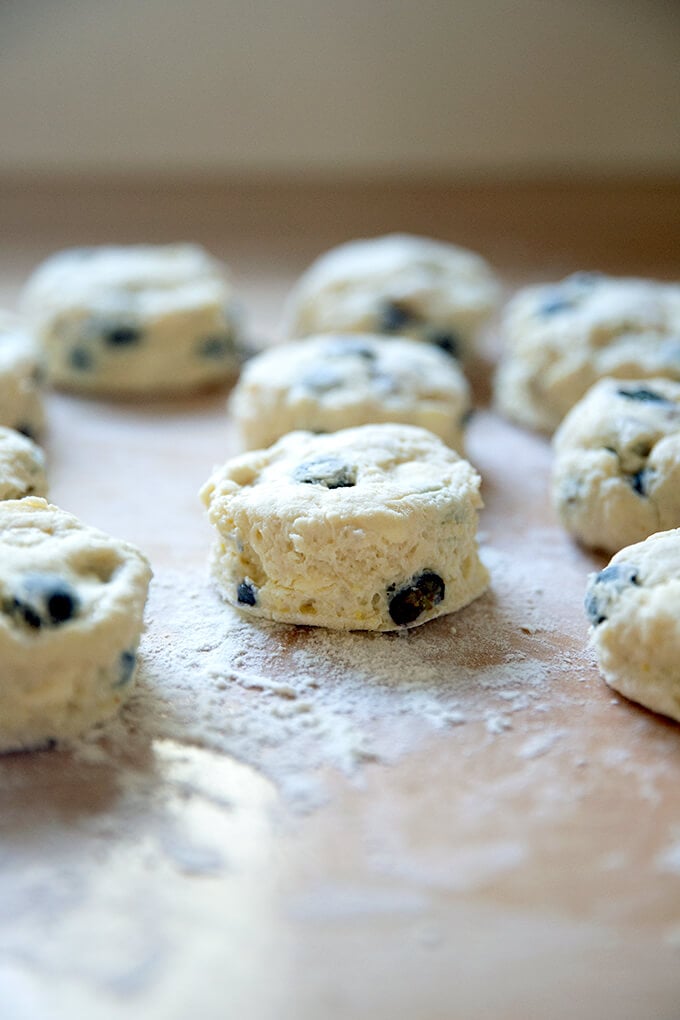
Transfer to a parchment lined sheet pan, and brush with butter and sprinkle with turbinado (or other sugar).

Bake at 400ºF for 20 minutes or until evenly golden:
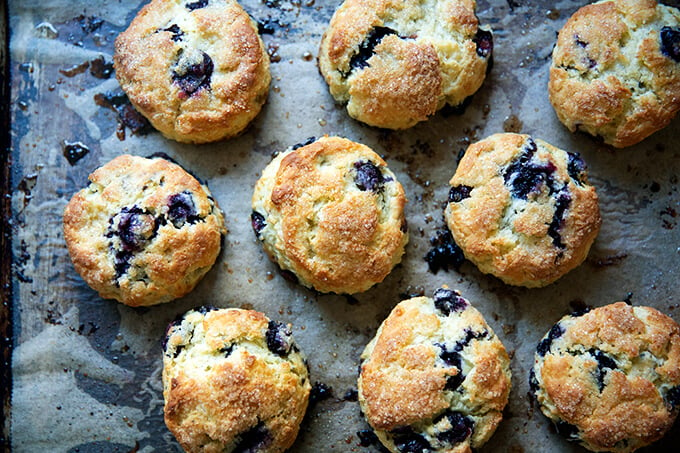
Transfer to a cooling rack for 5 minutes before serving with butter or jam on the side.
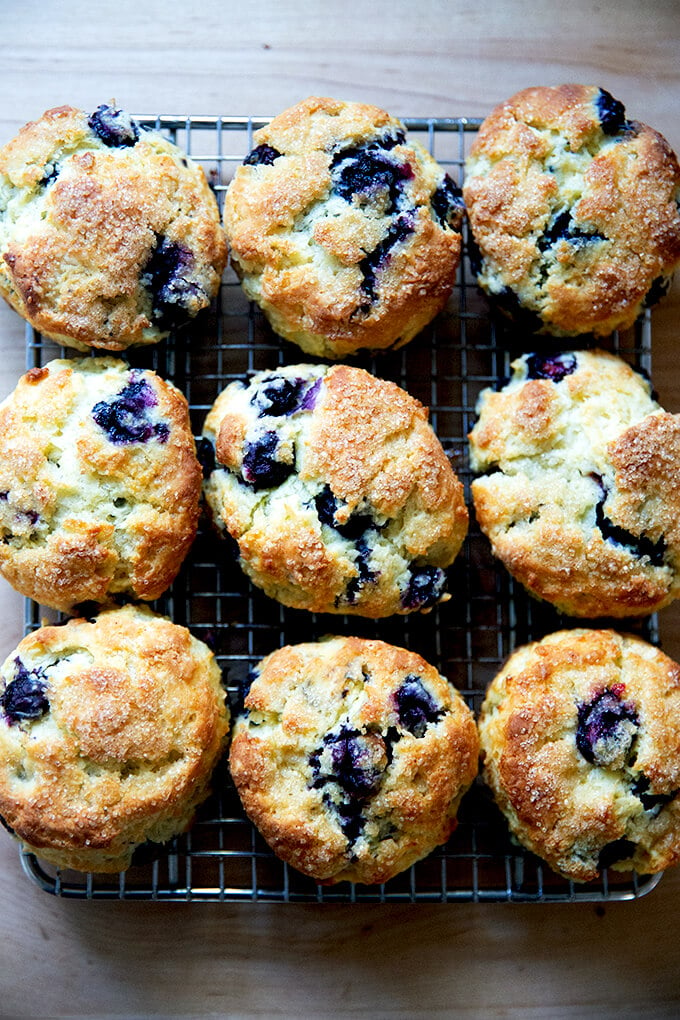
Use this recipe as a guide. These currant scones and cranberry scones are favorites as well:
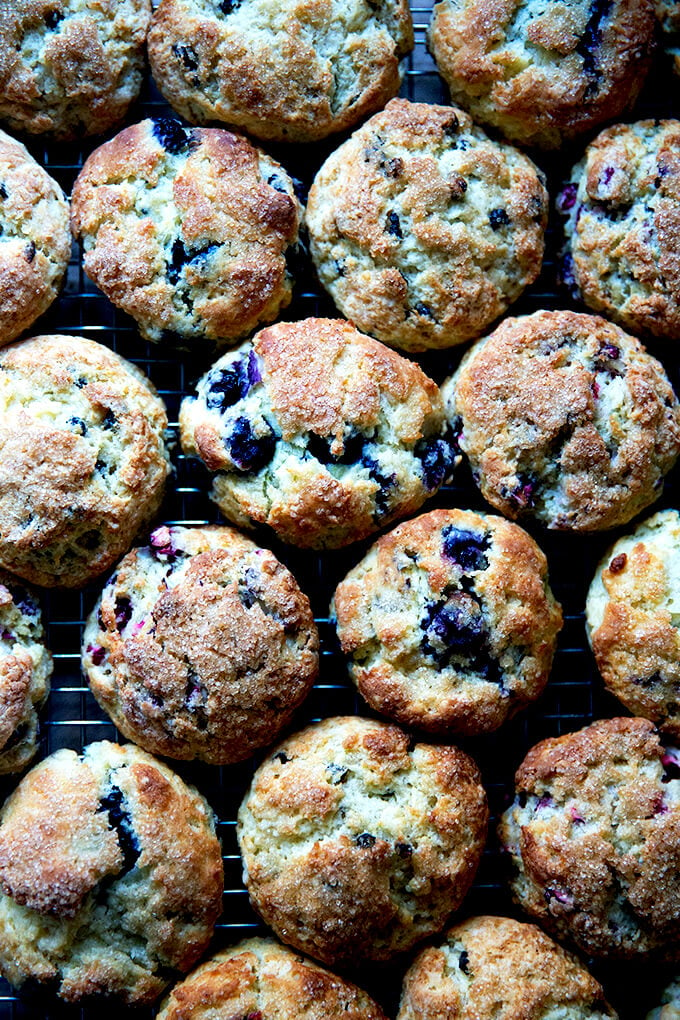
If you don’t feel like dealing with scraps and re-rolling the dough, simply cut it into triangles:




Fresh Lemon-Blueberry Scones
- Total Time: 45 minutes
- Yield: 6 to 8 large scones
Description
Adapted from Tartine’s recipe for currant scones.
UPDATE 5/12/2023: I recently updated my method, which is highlighted in bold in the recipe below. If you prefer the old method, see the notes below the recipe. In sum I now:
- Grate the butter using a box grater.
- Use 1/4 cup more blueberries.
- Use the same tea towel method I use for my pie dough to bring the dough together.
- Cut the dough into 6 large triangles as opposed to smaller circles.
As always, for best results, use a digital scale to measure.
To freeze: After you place the scones on a sheet pan, transfer them to the freezer. Freeze until solid; then transfer the scones to an airtight container or bag. When you are ready to bake, there’s no need to thaw them. Bake as directed below straight from the freezer. The scones shouldn’t take much longer to bake from frozen, but keep an eye on them at the 20-minute mark.
To make your own buttermilk:
- Place 1 tablespoon of vinegar or lemon juice in a liquid measuring cup.
- Fill cup with milk (2% or whole is best) until it reaches the 1-cup line.
- Let stand for five minutes. Use as directed.
Ingredients
- 2 1/3 cups (300 g) all-purpose flour
- 1.5 teaspoons (5 g) baking powder
- 0.5 teaspoon (3 g) baking soda
- 1/4 cup (50 g) sugar
- 1.25 teaspoons (6 g) salt
- zest of 1 lemon
- 1/2 cup (113 g) cold, unsalted or salted butter (I use salted)
- 1 to 1.25 cups (150 g to 195 g) fresh blueberries (I use 1.25 cups)
- 3/4 cup (190 g) buttermilk, plus more as needed
For finishing:
- 1.5 tablespoons melted butter
- sugar for sprinkling: turbinado is especially pretty but granulated is fine, too
Instructions
- Preheat the oven to 425ºF. Line a rimmed baking sheet with parchment paper.
- Whisk together the flour, baking powder, baking soda, sugar, salt, and lemon zest. Grate the stick of butter using a box grater, then scatter the shreds over the dry ingredients.
- Toss the butter with the dry ingredients and, using your hands, squeeze it gently to disperse it throughout the flour.
- Add the buttermilk and the blueberries, and mix gently with a spatula until you don’t see any dry patches in the dough — be patient here. The dough will still be shaggy and will not be a cohesive mass but when pinched, it should hold together. If the mixture seems dry, add a tablespoon more buttermilk (or more as needed). At this point, I now do what I do when I make pie dough: turn the crumbly dough out into the center of a large tea towel, grab the sides and twist the mass into a beggar’s purse, squeezing gently to help it form a disk. Open the tea towel and gently pat the dough as needed to help it come together.
- Dust your work surface with flour and turn the dough out onto it. Pat the dough into a 7-inch round circle. Brush the top with melted butter. Sprinkle with sugar. Use a bench scraper to cut the scones into 6 or 8 triangles (I prefer the larger size of the 6 scones, but they are on the large side, so do 8 if you prefer smaller scones.) Transfer the scones to the prepared sheet pan.
- Bake until the tops of the scones are lightly browned, 20 to 25 minutes. Remove from the oven, let cool briefly, then serve with butter on the side.
Notes
Old Method: Step 4 on
- Add the buttermilk and the blueberries, and mix gently with a spatula until the dough holds together. If the mixture seems dry, add a tablespoon more buttermilk (or more as needed). Knead gently if necessary.
- Using your hands, pat the dough into a rectangle about 1½ inches thick. Using a 2.5-inch biscuit cutter or any round cutter, cut each disk into about 8 circles. Gather the scraps together and repeat.
- Transfer scones to prepared sheet pan. (I like to chill my scones for 20 minutes at this point before baking them; you also can freeze the scones at this point — see notes above.) Brush the top with melted butter. Sprinkle with sugar. Note: You also can simply cut these into triangles or rectangles, which is easier.
- Previously I would place another sheet pan beneath the sheet pan holding the scones because often the bottom of my scones would burn, but I have since updated my sheet pans, and I am not having those issues. Something to keep in mind if you find your scones to be too brown on the bottom.
- Prep Time: 20 minutes
- Cook Time: 25 minutes
- Category: Breakfast
- Method: Oven
- Cuisine: American
This post may contain affiliate links. Please read my disclosure policy.






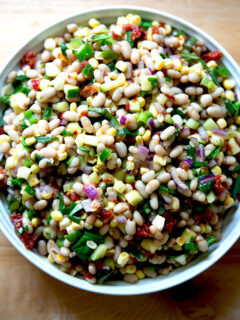




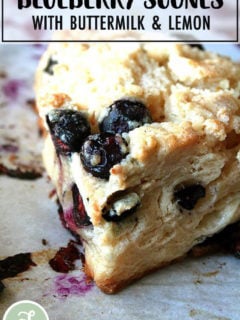










170 Comments on “Fresh Lemon-Blueberry Scones”
Make the scones and just push 8-10 of the frozen berries into the scones before putting them in the oven. Less chance of over mixing dough and doesn’t turn the entire dough bluberry blue. Delicious, berries stay plump.
Great idea!
Do you happen to know the weight measurements for these scones? It’s not easy to half this recipe without weights. My scones didn’t turn out anything like yours… I think everyone measures flour differently when using “cups”. Your photos look amazing!
Stephanie, so sorry for the delay here! If you look at this recipe, you will find the weights: https://alexandracooks.com/2012/11/13/tartines-currant-scones-lemon-cream/
I will update this recipe (sometime soon!) to have it include weight measurements, too.
Hello!
Quick question, did your scones ended up tasting more like a flaky biscuit? I can’t tell what I did wrong maybe I didn’t put enough buttermilk or maybe I didn’t cut the butter small enough. My scones turned out to be super buttery. Any words of advice?
These are super buttery scones! And yes, definitely biscuit-like. Are you looking for a dryer scone?
Posted picture on previous page, so DELICIOUS. Substituted finrly diced candied friut/perl for fresh blueberries and added 1/2 c golden raisins and tsp of frsh orange peel,!! It is Christmas celebration time and we are LOVING these!!! Crisp on the outside and so soft and buttery on the inside.
So happy to hear this Joyce!! I love these this time of year as well. So, so good.
Hi, these look delicious ????
Can I make them with chocolate chips? Would that change the recipe?
Thank you for sharing the recipe!
Yes! Go for it. No need to change the recipe.
Can I add rolled oats without changing the recipe? How much do you think I can add? Thanks!
Nice! May I know do you use fresh, frozen or dried blueberries?
Thanks! 🙂
This is the same recipe as La Brea Bakery’s in L.A. for ginger scones.
Where are the weights?
what are the nutritional facts for this recipe?
Can you make these with gluten free flour?
I haven’t tried with this recipe, but I have had success using Cup4Cup in other recipes.
I halved the recipe but kept the full lemon zest amount (1tsp), which was perfect. Made and then froze them; baked from frozen and they were just fine…took a couple more minutes to bake. I found that these baked better on convection than not (tried them both ways, so if you have the option, try convection bake). Also, used frozen blueberries and made buttermilk from milk and lemon juice. I’ve been searching for the perfect blueberry scone and for me, this is it!
So great to hear all of this, Megan! Great tips, too re convection baking, homemade buttermilk, frozen berries, etc. Thank you 😍😍😍
Delicious recipe as written – a keeper!
Wonderful to hear this, Anne!
Yum! Made these this morning – so good! Buttery, tender, delicious, and simple to put together, yay!
Wonderful to hear this, Jessica!
They came out perfectly! I grated the butter and it was pretty easy to mix it with the flour.
Wonderful to hear this, Anu! I love these this time of year. Smart to grate the butter!
Bangin!
This recipe yielded perfect, flaky yummy scones! I didn’t have any lemons ,so I used orange zest. I also threw in some Crasins. Very delicious, easy and gone fast!
Wonderful to hear this, Maria!
I loved this recipe. I made the half and it made 6 large scones…they were a hit and so easy to make!
Wonderful to hear this, Kathryn!
Can frozen blueberries be used? It is a wonderful recipe. Sometimes it is hard to find fresh blueberries, so I would like to try frozen ones next time.
Yes! No need to thaw before using. I’ll add a note to the recipe.
These look amazing and I would love to try them out .Do you think it would work to replace the buttermilk with kefir or yogurt?
Hi Lisa! I do! I would use the same amount by weight, and just use your judgment in terms of adding more liquid as needed to get the dough to come together… I don’t think the amount will be that different.
Thanks for this tasty and pretty scone recipe! I’ve often made scones and never thought of cutting them from rectangles with the width of the cutter/s in mind. Brilliant! A small thing but results in less re-cutting! Also, the chilling of the cut scones which lets them keep the tidy, pretty look. Great job!
Thank you Barbara 🙂 🙂 🙂
So delicious!!! Some scones taste dry to me, but I loved these!! What a good idea to use 2 sheet pans—the scone bottoms were perfectly crisp but not overdone! I will definitely make these again.
Great to hear this, Susanna! I use the double sheet pan when I bake challah, too, for the same reason. It’s such a great trick!
I tried to make this recipe this morning, super fail. I followed the directions including weighing all ingredients, weird that buttermilk wt for 1 cup WAY under 240 gms , unfortunately I errored and added too much buttermilk, ended up with a sticky mess that I threw out.
Also, how do you knead with blueberries without causing them to burst?
On another note I made the No knead pull apart rolls for Thanksgiving, made them ahead and froze. When baked they were kind of heavy. Maybe because I did not have them out long enough before baking? How long should they be out of freezer before baking?
Thank you, Julie O
Hi Julie!
Bummer to hear this. Question: So, did you measure 240 grams buttermilk, but then add more because it wasn’t a full cup by volume?
I will add some notes to the recipe bc I definitely use a very thick buttermilk from a local farm, so it probably is heavier per gram, which is why I always recommend going by the weight measure vs the volume measure bc the weight volume will always be more accurate.
Regarding folding the blueberries into the dough: you need to be gentle but swift. If you haven’t watched the video, that might provide some guidance. I’m sorry you threw the whole batter out! The batter is definitely on the wet side, and you can always make drop biscuits if it’s too sticky to handle.
Regarding the rolls, when did you freeze them? Before baking them or post baking them?
Really easy and nice for a quick weekend breakfast. Will put this into regular rotation.
Wonderful to hear this, Ali!
Wow these were amazing. Thank you. Five stars from everyone in my family. I followed the recipe exactly. Yum
Great to hear, Melinda! Thanks for writing 🙂
First time making this today. It turned out flacky outside but moist inside. My daughter said it’s bland – she can’t even taste the sugar. Personally, I like it. For next time, maybe increase the sugar and add vanilla extract? Otherwise, really good and easy to follow recipe.
Absolutely! This is definitely a recipe you can adjust to taste — add more sugar, more vanilla, etc.
I have been making this recipe for over a year and love the updated version. I did make my usual triangles this time but will use the biscuit cutters next time! Thank you! My whole family loves these scones!!
Wonderful to hear this, Jennifer! Thanks so much for writing. Triangles really do make the most sense 🙂 🙂 🙂
Love this recipe! Just made them and they were easy to make and came out perfectly! I liked the idea of doubling the pan for baking, worked like a charm. We’re not big sugar fans, so these are so much better than any bakery bought scones we’ve had – no where near as sweet, so great for us. The only thing I may change next time is to add more lemon zest. We’d like to taste a bit more of the lemon, but that’s really a personal preference. Thanks so much for sharing this recipe!
Wonderful to hear this, Maria! More and more I prefer things less sweet, too. Glad you enjoyed these!
I followed this recipe to a T and these scones came out fluffy, buttery, and absolutely mouth watering! I’ve only had one good scone in my life from a local bakery; the ones at chain restaurants/bakeries/grocery stores are just tasteless, hard, and awful. I never thought I’d make them at home but I had some leftover buttermilk and this recipe was so easy that I had to give it a try. I used Meyer lemon zest and if I use it again rather than a regular lemon, I will definitely add more zest. Thanks for a fabulous recipe!
Wonderful to hear this, Alli! I think there’s ALWAYS more room for lemon zest 🙂 Thanks so much for writing.
I love this recipe. I was never one to reach for the scone at the bakery but this has totally changed me! I also love how easy it is to freeze the dough and bake just one or two in the morning. Tastes just as good that everyone thinks I woke up at the crack of dawn and spent hours making homemade pastries 🙂
Oh I love this, Natalie 🙂 🙂 🙂 Thanks so much for writing. Great to hear.
Delicious! And who knew making scones was so easy? Will be making your other versions, too, very soon!
Great to hear, Victoria!